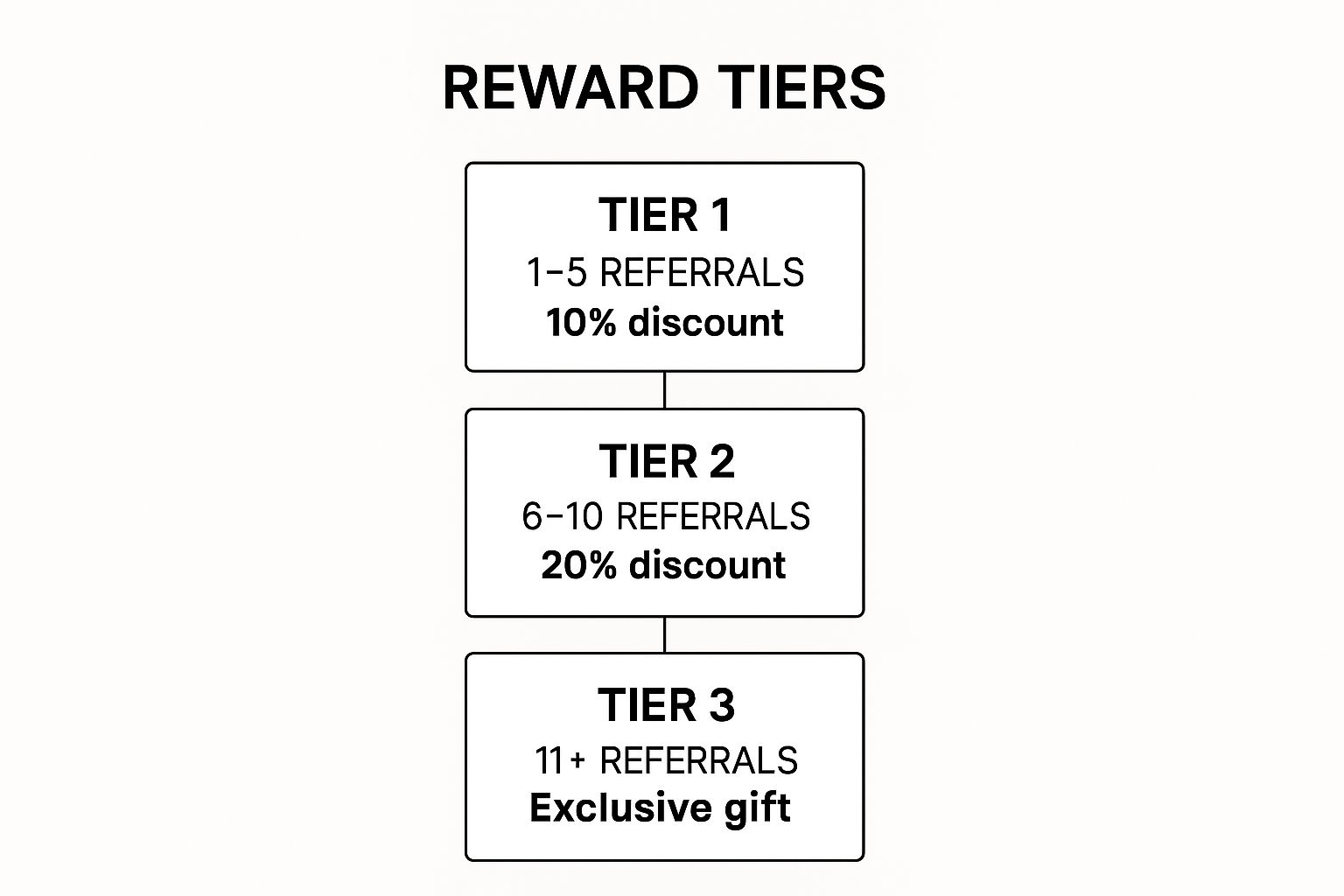Unlocking Growth: Supercharging SaaS with Referrals
Want to lower customer acquisition costs (CAC) and boost your SaaS growth? Referral programs are key. This listicle reveals six referral program best practices to maximize customer acquisition and retention. Learn how to offer compelling two-sided incentives, simplify sharing, optimize referral timing, clarify program terms, implement tiered rewards, and track your program's success. By applying these referral program best practices, you can turn satisfied users into your most powerful growth engine.
1. Offer Two-Sided Incentives
One of the most effective referral program best practices is implementing a two-sided incentive structure. This approach rewards both the referrer (your existing customer) and the referee (the new customer they bring in). By incentivizing both parties, you remove the friction often associated with asking for or accepting a referral, creating a win-win scenario that benefits everyone involved. This fosters a sense of fairness and encourages active participation, ultimately driving significant growth.

Two-sided incentives offer flexible reward options, including cash, discounts, store credit, free products, or additional service features. These rewards can be distributed immediately upon a successful referral or tied to specific milestones, such as the new customer's first purchase or a certain period of engagement with your product. This flexibility allows you to tailor the program to your specific business model and target audience. Two-sided programs typically see higher conversion rates compared to one-sided programs, as the dual incentive creates a stronger motivation for both parties to participate.
Examples of Successful Implementation:
- Airbnb: Offers travel credits to both the referrer and referee. Referrers receive a credit when a friend books a stay and an additional credit when they host.
- Dropbox: Famously doubled its user base in 15 months by offering both referrers and referees 500MB of extra storage space. This directly tied the reward to the product's core value proposition.
- PayPal: Fueled early growth by offering $10 to both new users and referrers upon successful signup and transaction. This direct cash incentive rapidly expanded their user base.
Why Use Two-Sided Incentives?
This approach deserves a top spot in any list of referral program best practices because it directly addresses the core challenge of encouraging participation. By offering value to both sides, you create a powerful motivator that accelerates word-of-mouth marketing and drives both customer acquisition and retention. It also cultivates a sense of community and shared benefit among your users.
Pros:
- Higher participation rates compared to one-sided programs.
- Creates a sense of fairness and equity within the program.
- Accelerates word-of-mouth marketing organically.
- Improves both acquisition and retention metrics.
Cons:
- Higher initial cost per acquisition.
- Requires careful financial modeling to ensure long-term profitability.
- Potential to attract discount-seekers if incentives aren't structured strategically.
Tips for Implementation:
- Test different incentive values: Find the optimal balance between program cost and conversion rates through A/B testing.
- Consider your product's price point: Reward value should typically be between 10-25% of the product's value.
- Make rewards relevant: Tie incentives to your product experience (like Dropbox's extra storage) rather than generic cash rewards whenever possible.
- Communicate clearly: Emphasize the dual benefits of the referral program in all your marketing materials.
For early-stage startups, self-serve SaaS companies, product-led growth SaaS, SaaS founders, and indie hackers, a well-structured two-sided referral program can be a game-changer, providing a cost-effective and scalable way to acquire new customers and build a loyal user base. Remember to continuously analyze and optimize your program based on performance data to maximize its impact on your growth trajectory.
2. Make Sharing Simple and Frictionless
One of the most crucial referral program best practices is minimizing friction in the sharing process. This means making it as easy as possible for your existing customers to refer their friends. Every extra click, form field, or complicated step significantly reduces the likelihood of a successful referral. A seamless and intuitive sharing experience is paramount to driving high participation rates and maximizing the impact of your program. Think one-click sharing, personalized links, and pre-written messages ready to go. This approach transforms your advocates into effortless marketers, amplifying your reach and growth.

A frictionless referral program typically includes features like one-click sharing options across multiple channels (email, social media, messaging apps), personalized referral links or codes that are easy to remember and share, and a mobile-optimized sharing experience. Pre-written messaging templates that users can customize and visual assets that make sharing more engaging can also boost participation. These features are crucial for product-led growth SaaS, indie hackers, and SaaS founders looking to scale quickly.
The benefits of streamlined sharing are numerous. Higher participation rates are a direct result of the reduced effort required. Increased program visibility through multi-channel promotion expands your reach significantly. Furthermore, implementing personalized links or codes enables better tracking and attribution of successful referrals, providing valuable data for program optimization. A smooth user experience fosters positive brand associations, further reinforcing customer loyalty.
However, there are some potential drawbacks to consider. Implementing these features across multiple platforms can be technically complex. Ongoing maintenance is required as sharing platforms and technologies evolve. Finally, ensuring robust security measures to prevent link/code fraud is vital.
Several companies have demonstrated the power of frictionless sharing. Uber's referral program, popularizing easy mobile app referrals along with Lyft, uses personalized, short, and memorable codes. Tesla offers a simple sharing interface with personalized referral links and integrated social sharing buttons. Harry's, a prime example of a successful pre-launch campaign spearheaded by Jeff Raider and Andy Katz-Mayfield, captured 100,000 emails before launch through a streamlined referral mechanism with clear sharing options. The Robinhood waitlist referral program also achieved viral pre-launch growth using similar tactics. These are excellent examples for early-stage startups and self-serve SaaS companies to emulate.
Here are some actionable tips to optimize your referral program for frictionless sharing:
- Integrate sharing options directly into the post-purchase flow: Capitalize on the peak of customer satisfaction immediately after a purchase.
- A/B test different sharing interfaces: Identify the design and flow that yields maximum participation.
- Ensure mobile responsiveness: Your referral program must function flawlessly across all devices.
- Create short, memorable referral codes: Facilitate easy verbal sharing.
- Provide template messages: Offer pre-written content that reflects your brand voice while allowing for personalization.
By prioritizing ease of sharing, you significantly increase the chances of your referral program becoming a powerful engine for growth. Learn more about Make Sharing Simple and Frictionless and unlock the full potential of referral marketing. This best practice deserves its place on the list because it directly addresses a major barrier to participation, making it easier for your customers to spread the word and ultimately boosting your bottom line.
3. Strategic Timing of Referral Requests
Timing is everything when it comes to referral program best practices. Asking for a referral at the wrong moment can be ineffective at best and detrimental at worst. Strategic timing maximizes your chances of success by focusing on moments of peak customer satisfaction – after a positive experience, successful outcome, or milestone achievement – when customers are most likely to become enthusiastic advocates. This approach transforms a potentially disruptive ask into a natural extension of a positive customer journey.

Instead of a blanket approach, strategic timing leverages data and customer behavior to personalize the referral request. This involves integrating the referral program with your customer journey map to pinpoint those "magic moments" where customers are most receptive. Features like triggered referral requests based on engagement metrics, automated yet personalized timing, and a progressive engagement approach (escalating requests as the customer relationship deepens) are key components. Think of it as nurturing your customer towards becoming an advocate, rather than abruptly soliciting a referral. This is particularly important for early-stage startups, self-serve SaaS companies, product-led growth SaaS, SaaS founders, and indie hackers who are building their initial customer base and relying heavily on word-of-mouth marketing.
For example, Stitch Fix cleverly asks for referrals after customers keep items from their delivery, a clear signal of satisfaction. Similarly, Slack prompts for referrals after teams reach active usage milestones, indicating they're experiencing the platform's value. Evernote triggers requests after users create a certain number of notes, demonstrating engagement and successful product adoption. These companies understand that a well-timed referral request is far more effective than a generic, impersonal one.
Pros of Strategic Timing:
- Higher conversion rates: Customers are more receptive when they're already experiencing the value of your product or service.
- More authentic referrals: Referrals stem from genuine positive experiences, leading to more credible endorsements.
- Reduced referral fatigue: Avoid annoying customers with poorly timed requests, preserving your brand image.
- Better quality referrals: Happy customers refer other high-potential customers, contributing to higher lifetime value.
Cons of Strategic Timing:
- Requires sophisticated data analysis: Understanding your customer journey and identifying key touchpoints requires data and analysis.
- More complex to implement: Setting up triggered and personalized requests requires more technical setup than a static program.
- Potential for missed opportunities: If timing algorithms aren't optimized, you might miss prime referral opportunities.
Actionable Tips for Implementation:
- Analyze customer feedback and NPS scores: Identify high-satisfaction touchpoints.
- Implement post-purchase referral prompts: Capitalize on the immediate post-purchase glow.
- Create milestone-based referral triggers: Tie requests to product usage or account history.
- Use behavioral triggers: Leverage actions like repeat purchases or feature engagement.
- Test and compare conversion rates: Experiment with different timings to find what works best for your specific audience.
Strategic timing of referral requests deserves its place in the list of best practices because it directly impacts the effectiveness of your referral program. It elevates the process from a simple ask to a strategic component of your customer journey, leading to more authentic, higher-quality referrals and ultimately, sustainable growth. By taking cues from companies like Amazon, LinkedIn, Slack, and Evernote, even early-stage companies can leverage the power of strategic timing to amplify their referral program's success.
4. Clear and Transparent Program Terms
A cornerstone of any successful referral program is transparency. Clear and transparent program terms are crucial for building trust and encouraging participation among your target audience – early-stage startups, self-serve SaaS companies, product-led growth SaaS, SaaS founders, and indie hackers. This best practice ensures everyone understands how the program works, what's expected of them, and what rewards they can anticipate. Ambiguity breeds frustration, leading to lower participation rates and even negative word-of-mouth. Conversely, when you prioritize clarity, you create a sustainable program that fosters trust and generates positive results.
This approach involves openly communicating all aspects of your referral program: the conditions for participation, the reward structure, and any limitations. This means using plain, simple language that's easy to understand. Think 6th-8th grade reading level. Learn more about Clear and Transparent Program Terms for in-depth guidance on structuring your program effectively.
Features of a Transparent Referral Program:
- Easily accessible program rules in plain language: Avoid legal jargon and complex sentence structures.
- Visual explanations: Infographics, videos, and flowcharts can simplify complex processes and make them more engaging.
- Transparent tracking of referral status: Provide participants with a dashboard or regular updates so they can monitor their referrals and rewards.
- Clear qualification criteria and timelines for rewards: Specify exactly what actions trigger a reward and when participants can expect to receive them.
- Regular communication about referral progress and reward status: Proactive updates keep participants engaged and informed.
Pros of Transparent Terms:
- Builds Trust: Honesty and openness foster trust with your users, encouraging them to participate actively.
- Reduces Customer Service Inquiries: Clear terms preemptively address common questions, freeing up your customer support team.
- Prevents Negative Experiences: Misunderstandings about the program can lead to negative experiences. Transparency minimizes this risk.
- Creates a Sustainable Program: Fewer disputes and complaints contribute to a long-lasting and effective referral program.
Cons of Transparent Terms:
- May Highlight Program Limitations: Being upfront about limitations might initially deter some potential participants.
- Requires Careful Legal Review: Balancing clarity with legally sound terms requires careful consideration and review.
- Can Appear Restrictive: Overly complex rules, even if transparent, can make the program seem restrictive and less appealing.
Examples of Successful Implementation:
- Wise (formerly Transferwise): Uses a simple three-step visual explanation of their referral program, clearly outlining the reward amounts for both the referrer and the referred friend.
- Coinbase: Clearly states all limitations and eligibility requirements upfront, including country restrictions, ensuring transparency from the start.
- T-Mobile: Provides a dedicated tracking dashboard allowing participants to monitor the status of their referrals in real-time.
Actionable Tips for Implementing Transparent Terms:
- Use Simple Language: Write your terms at a 6th-8th grade reading level for maximum comprehension.
- Create Visual Flowcharts: Illustrate the referral and reward process with clear visuals.
- Provide Real-Time Tracking: Empower users to track their referral status independently.
- Send Automatic Notifications: Keep participants informed at each stage of the referral process with automated email or in-app notifications.
- Include Clear FAQs: Address common questions proactively in a dedicated FAQ section.
- Seek Legal Review: Have your terms reviewed by legal counsel while maintaining clarity for the average user.
By incorporating these best practices, you can leverage clear and transparent terms to create a referral program that builds trust, fosters engagement, and drives sustainable growth for your business. This is a crucial element of referral program best practices and is essential for achieving long-term success. Remember, transparency is not just about disclosing information; it's about building a strong foundation of trust with your users. This trust, in turn, translates into higher participation rates, more successful referrals, and ultimately, a more thriving business. Companies like Amazon Associates, Wise, and REI Co-op have demonstrated the power of transparency in their referral programs, setting a benchmark for others to follow.
5. Tiered and Milestone Rewards Systems
One of the most effective referral program best practices for driving sustained engagement is implementing a tiered or milestone-based reward system. This approach moves beyond a simple one-time reward for each referral and instead introduces a progressive incentive structure where rewards increase in value as participants refer more customers. This gamified approach not only encourages ongoing participation but also identifies and handsomely rewards your most valuable brand advocates.

The infographic above visualizes the hierarchical relationship between the core components of a tiered referral program. At the top, we have the overall goal: Increased Customer Acquisition. This is achieved through driving Referrals, which is fueled by the tiered reward system. This system is broken down into three key elements: Increasing Rewards, Status Levels, and Milestone Achievements. Each of these elements contributes to motivating referrers and driving the desired outcome. Increasing rewards provide tangible benefits, status levels offer recognition and exclusivity, and milestone achievements provide clear targets and a sense of progress. Finally, the infographic highlights that all of this leads to improved ROI by focusing rewards on the most productive referrers.
This method works by establishing different tiers or milestones within the referral program. As participants successfully refer more customers, they climb the ladder, unlocking increasingly valuable rewards at each level. These rewards can range from larger discounts and exclusive merchandise to premium features, early access to new products, or even high-value prizes like a free subscription or a significant cash bonus.
Examples of successful tiered referral programs abound. Tesla's early referral program, which at its peak offered top referrers a free vehicle, generated significant buzz and boosted sales. Uber Eats offers increasingly valuable rewards as drivers refer more colleagues, ensuring a steady stream of new drivers. Morning Brew, the popular newsletter, leveraged a tiered referral system where subscribers unlocked branded merchandise and experiences at different referral levels, helping them grow to over 1.5 million subscribers. These companies demonstrate the power of tiered rewards in driving rapid growth and customer acquisition.
Features of a Tiered System:
- Progressive Reward Structure: Rewards increase in value with each referral milestone.
- Status Levels/Tiers: Clear designations for referrers based on their performance.
- Achievement Milestones: Specific referral targets that unlock rewards.
- Leaderboards/Progress Indicators: Visual representation of referral performance and proximity to the next tier.
- Exclusive Rewards for Top Referrers: High-value incentives for top performers.
Pros:
- Motivates Continued Participation: Incentivizes referrers beyond a single referral.
- Drives Higher Engagement: Creates a competitive element and fosters a sense of achievement.
- Identifies and Rewards Top Advocates: Highlights your most valuable referrers and encourages their continued participation.
- Improves ROI: Focuses rewards on the most productive referrers, maximizing return on investment.
- Gamification: Adds a fun and engaging element to the referral process.
Cons:
- Complex Implementation: Requires more planning and administration compared to simpler programs.
- Potential for Demotivation: New referrers may be discouraged if initial rewards seem insufficient.
- Financial Modeling: Careful planning is crucial to ensure profitability at higher reward tiers.
Tips for Implementation:
- Start Small: Begin with attainable early milestones to build momentum and engagement.
- Visual Progress: Use progress bars or leaderboards to show referrers how close they are to the next tier.
- Exclusive Rewards: Offer unique experiences or limited-edition items at top tiers to enhance perceived value.
- Time-Limited Tiers/Bonuses: Create urgency with seasonal bonuses or limited-time reward tiers.
- Celebrate Top Referrers: Publicly acknowledge (with permission) top performers to inspire others.
Tiered and milestone rewards systems are particularly well-suited for early-stage startups, self-serve SaaS companies, and product-led growth SaaS businesses looking to rapidly expand their customer base. By tapping into the competitive spirit of their users and rewarding their most loyal advocates, these companies can ignite viral growth and achieve significant customer acquisition at a relatively low cost. This approach is a powerful tool for indie hackers and SaaS founders aiming for sustainable and scalable growth through referral program best practices.
6. Comprehensive Tracking and Analytics
Implementing a referral program is only half the battle. To truly unlock its potential and maximize its impact on your growth trajectory, especially as an early-stage startup, self-serve SaaS company, or product-led growth SaaS, you need comprehensive tracking and analytics. This critical best practice empowers you to understand what's working, what's not, and how to continuously optimize your program for better results. Without robust tracking, your referral program is essentially flying blind.
Comprehensive tracking and analytics involves meticulously monitoring every stage of the referral journey, from the initial share by a referrer to the final conversion of a referred friend. This data-driven approach provides invaluable insights into program performance, referral sources, and conversion rates. These insights allow for data-driven optimization, fraud prevention, and demonstration of program ROI, proving its value to stakeholders and justifying continued investment.
Features of a Robust Referral Tracking System:
- End-to-end referral journey tracking: Follow the entire process from initial share to conversion, identifying any bottlenecks or drop-off points.
- Attribution models: Accurately credit referral sources, even in multi-touch attribution scenarios where multiple marketing efforts influence a conversion. This allows you to pinpoint which channels and referrers are most effective.
- A/B testing capabilities: Experiment with different program variations, such as incentive amounts, messaging, and timing, to identify what resonates best with your audience.
- Fraud detection algorithms: Identify and prevent suspicious patterns that could undermine program economics. As an indie hacker or SaaS founder, protecting your resources is crucial.
- Integration with broader marketing analytics: Seamlessly incorporate referral data into your overall marketing analytics to get a holistic view of customer acquisition.
- Customer segmentation based on referral behavior: Identify your most valuable referrers and tailor your program to their specific needs and preferences.
Pros of Implementing Robust Tracking:
- Enables continuous optimization: Data-driven insights allow for informed decisions about program adjustments, leading to improved performance.
- Identifies most valuable referral channels and customer segments: Focus your efforts on the areas that generate the highest ROI.
- Provides clear ROI metrics: Justify program investment by demonstrating its tangible impact on customer acquisition and revenue.
- Prevents fraud: Protect your program from abuse and ensure its long-term sustainability.
- Allows for personalization: Tailor your messaging and incentives based on referral patterns to maximize engagement.
Cons to Consider:
- Can require significant technical implementation: Setting up a comprehensive tracking system can be complex, especially for smaller teams.
- May face challenges with cross-device attribution: Accurately tracking referrals across multiple devices can be difficult.
- Privacy regulations can limit certain tracking capabilities: Ensure your tracking practices comply with relevant data privacy laws.
- Risk of over-focusing on metrics at the expense of customer experience: Remember that the ultimate goal is to create a positive referral experience for both referrers and referred friends.
Examples of Successful Implementation:
- Airbnb's referral program 2.0: Their sophisticated tracking led to a 34% increase in referral sends and a remarkable 300% boost in conversions.
- Groupon: Their analytics system identifies and rewards their most valuable referrers based on the quality of conversions, not just quantity.
- Robinhood: They leverage attribution modeling to understand which referral channels bring in the highest-value customers.
Actionable Tips for Your Referral Program:
- Implement multi-touch attribution models: Account for all touchpoints in the customer journey, not just the last click.
- Set up regular A/B tests on key program variables: Experiment with incentive amounts, messaging, and timing to find the optimal combination.
- Create custom dashboards that highlight key performance indicators: Track metrics like referral rate, conversion rate, and customer lifetime value.
- Segment analytics by customer type, acquisition channel, and lifetime value: Identify your most valuable customer segments and tailor your program accordingly.
- Implement fraud scoring systems to flag suspicious referral patterns: Protect your program from abuse.
- Schedule regular program reviews based on analytics insights: Continuously optimize your program based on data-driven feedback.
Companies like Airbnb (whose data science team's referral program optimization is a famous case study), Mention (a social media monitoring company that built their entire growth strategy around referral analytics), and attribution platforms like Branch.io have popularized the importance of referral program tracking. Learn more about Comprehensive Tracking and Analytics. By prioritizing tracking and analytics in your referral program, you’re not just collecting data, you’re gaining a competitive edge and maximizing the potential of this powerful growth channel. This is essential for referral program best practices, especially for those operating in the fast-paced SaaS environment.
Referral Program Best Practices Comparison
| Best Practice | Implementation Complexity 🔄 | Resource Requirements ⚡ | Expected Outcomes 📊 | Ideal Use Cases 💡 | Key Advantages ⭐ |
|---|---|---|---|---|---|
| Offer Two-Sided Incentives | Medium to High: Requires financial modeling and dual reward setup | Moderate to High: Budget for rewards on both sides | Higher conversion and participation rates; improved acquisition and retention | Programs aiming to maximize engagement and fairness | Win-win structure; accelerates word-of-mouth; higher participation |
| Make Sharing Simple and Frictionless | High: Complex cross-platform tech and maintenance | Moderate: Technical resources for integration and upkeep | Increased participation and program visibility; better tracking | Programs focusing on ease of use and broad reach | Reduces sharing barriers; boosts multi-channel promotion; enhances UX |
| Strategic Timing of Referral Requests | High: Needs customer data analysis and journey mapping | Moderate: Analytics tools and integration | Higher conversion due to timely asks; better referral quality | Customer journeys with defined satisfaction milestones | Improves receptivity; authentic referrals; reduces referral fatigue |
| Clear and Transparent Program Terms | Low to Medium: Focus on clear communication and legal review | Low: Content creation and legal resources | Builds trust and reduces disputes; increases satisfaction | Programs needing long-term sustainability and trust | Enhances transparency; lowers support queries; prevents misunderstandings |
| Tiered and Milestone Rewards Systems | High: Complex reward structure and program logic | Moderate to High: Cost of escalating rewards and gamification elements | Higher engagement and motivation; rewarding top referrers | Programs targeting high-value, ongoing participation | Motivates continued referrals; gamification boosts engagement; recognizes top advocates |
| Comprehensive Tracking and Analytics | High: Significant tech build for tracking, attribution, and fraud prevention | High: Analytics platforms and technical expertise required | Data-driven optimization; fraud reduction; clear ROI demonstration | Large-scale programs needing performance insights | Enables continuous improvement; identifies valuable channels; fraud detection |
Powering Your SaaS Growth with Referral Program Best Practices
Successfully implementing a referral program isn't about luck; it's about strategy. This article has outlined six key referral program best practices: offering two-sided incentives, simplifying the sharing process, strategically timing referral requests, maintaining transparent program terms, implementing tiered rewards, and utilizing comprehensive tracking and analytics. Mastering these core elements is crucial for transforming your satisfied customers into enthusiastic advocates and unlocking the true potential of referral marketing. These strategies empower you to build a sustainable growth engine fueled by word-of-mouth marketing, significantly reducing your reliance on expensive advertising campaigns.
One particularly effective strategy to supercharge your referral program is through influencer collaborations. Influencer marketing, when done right, can be a powerful driver of referral program success. Leveraging influencer marketing best practices (2025 Influencer Marketing Best Practices: Boost Your Brand from Influencer Marketing Jobs) can significantly expand your reach and bring authenticity to your referral campaigns.
By focusing on these referral program best practices, you can create a program that not only benefits your business but also provides real value to your customers. This creates a win-win situation, fostering stronger customer relationships and driving sustainable growth. Remember, a well-executed referral program is more than just a marketing tactic; it's a powerful tool for building a thriving community around your product.
Ready to streamline your referral program and unlock its full potential? Refgrow provides the tools and features you need to implement, manage, and track your referral programs seamlessly. Visit Refgrow today and start leveraging the power of referrals to achieve sustainable SaaS growth.

